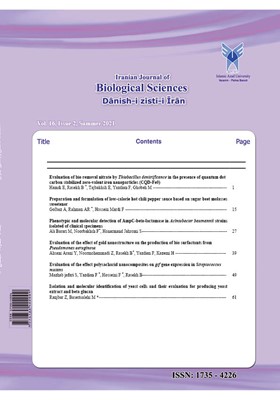-
-
List of Articles
-
Open Access Article
1 - Evaluation of bio removal nitrate by Thiobacillus denitrificance in the presence of quantum dot carbon stabilized zero valent iron nanoparticles (CQD-Fe0)
elahe hamdi behnam rasekh elahe tajbakhsh fatemeh yazdian maryam ghobeh -
Open Access Article
2 - Preparation and formulation of low-calorie hot chili pepper sauce based on sugar beet molasses sweetener
ayda golbaaz alireza rahman Fateme hoseinmardi -
Open Access Article
3 - Phenotypic and molecular detection of AmpC-beta-lactamase in Acintobacter baumannii strains isolated of clinical specimens
Masoumeh Ali Barari Fatemeh Noorbakhsh Sahar Honarmand Jahromi -
Open Access Article
4 - Evaluation of the effect of gold nanostructure on the production of bio surfactants from Pseudomonas aeruginosa
Yaser Ahsani Arani Zahra Noormohammadi behnam rasekh fatemeh Yazdian Hojjat kazemi -
Open Access Article
5 - Evaluation of the effect polysacharid nanocomposites on gtf gene expression in Streptococcus mutan
Shokofeh Mazhab jafari fatemeh Yazdian Farzaneh Hosseini behnam rasekh -
Open Access Article
6 - Isolation and molecular identification of yeast cells and their evaluation for producing yeast extract and beta glucan
zohreh ranjbar majid baserisalehi
-
The rights to this website are owned by the Raimag Press Management System.
Copyright © 2021-2025







